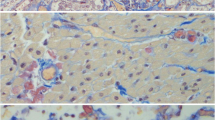Abstract
Background
Extra-renal involvement in hemolytic uremic syndrome (HUS) includes gastrointestinal, pancreatic, hepatic, neurological and cardiac manifestations. The current 3–5% mortality rate in HUS patients is primarily attributed to complications related to the central nervous system and the heart. In this brief report, we illustrate that severe cardiac involvement in a patient with HUS is potentially reversible using cardiopulmonary bypass as rescue.
Case-Diagnosis/Treatment
A 12-year-old boy was diagnosed with enterohemorrhagic Escherichia coli-induced HUS related to E. coli serotypes O55:H7 and O121:H19. The patient developed anuria and hypertension of 150/105 mmHg and had neurological symptoms, with lethargy, confusion and later a tonic-clonic seizure successfully treated with midazolam. Laboratory tests on blood samples revealed acute renal failure, with a creatinine level of 3.98 mg/dL, thrombocytopenia of 47 × 109/L, lactate dehydrogenase level of 3620 IU/L, low haptoglobin (<20 mg/dL), anemia (10.0 g/dL) and schistocytes on blood smears. Peritoneal dialysis was initiated without complications. Serum potassium level was normal. At day 3, the patient suffered cardiac arrest on two separate occasions. Troponin-T, creatine kinase and creatine kinase-MB levels were significantly increased. The second episode of cardiac arrest could not be reversed with advanced cardiopulmonary resuscitation, and a cardiopulmonary bypass circuit was established. Declining cardiac pump function to a near non-contractile state with an ejection fraction of <10% was observed on echocardiography. This persisted during the following days. After the patient had been on the cardiopulmonary bypass (CPB) circuit for 7 days, the myocardium slowly recovered function. Three days later, the CPB was successfully discontinued; the echocardiography showed near-normal ejection fraction, and electrocardiography (ECG) showed sinus rhythm.
Conclusions
Fatal outcome in patients with HUS may be the result of severe cardiac involvement. The present case illustrates the need for intensive supportive care, including the use of CPB, as the cardiac symptoms in HUS patients may be reversible. We suggest the monitoring of cardiac-specific enzymes, ECG and echocardiography in high-risk patients.

Similar content being viewed by others
References
Scheiring J, Andreoli SP, Zimmerhackl LB (2008) Treatment and outcome of Shiga-toxin-associated hemolytic uremic syndrome (HUS). Pediatr Nephrol 23:1749–1760
Karpman D, Loos S, Tati R, Arvidsson I (2017) Haemolytic uraemic syndrome. J Intern Med 281:123–148
Oakes RS, Siegler RL, McReynolds MA, Pysher T, Pavia AT (2006) Predictors of fatality in postdiarrheal hemolytic uremic syndrome. Pediatrics 117:1656–1662
Jenssen GR, Vold L, Hovland E, Bangstad HJ, Nygard K, Bjerre A (2016) Clinical features, therapeutic interventions and long-term aspects of hemolytic-uremic syndrome in Norwegian children: a nationwide retrospective study from 1999–2008. BMC Infect Dis 16:285
Mohammed J, Filler G, Price A, Sharma AP (2009) Cardiac tamponade in diarrhoea-positive haemolytic uraemic syndrome. Nephrol Dial Transplant 24:679–681
Abu-Arafeh I, Gray E, Youngson G, Auchterlonie I, Russell G (1995) Myocarditis and haemolytic uraemic syndrome. Arch Dis Child 72:46–47
Rigamonti D, Simonetti GD (2016) Direct cardiac involvement in childhood hemolytic-uremic syndrome: case report and review of the literature. Eur J Pediatr 175:1927–1931
Thomas NJ, Messina JJ, DeBruin WJ, Carcillo JA (2005) Cardiac failure in hemolytic uremic syndrome and rescue with extracorporeal life support. Pediatr Cardiol 26:104–106
Askiti V, Hendrickson K, Fish AJ, Braunlin E, Sinaiko AR (2004) Troponin I levels in a hemolytic uremic syndrome patient with severe cardiac failure. Pediatr Nephrol 19:345–348
Thayu M, Chandler WL, Jelacic S, Gordon CA, Rosenthal GL, Tarr PI (2003) Cardiac ischemia during hemolytic uremic syndrome. Pediatr Nephrol 18:286–289
Bridges BC, Hardison D, Pietsch J (2013) A case series of the successful use of ECMO, continuous renal replacement therapy, and plasma exchange for thrombocytopenia-associated multiple organ failure. J Pediatr Surg 48:1114–1117
Gerber A, Karch H, Allerberger F, Verweyen HM, Zimmerhackl LB (2002) Clinical course and the role of shiga toxin-producing Escherichia coli infection in the hemolytic-uremic syndrome in pediatric patients, 1997–2000, in Germany and Austria: a prospective study. J Infect Dis 186:493–500
Kielstein JT, Beutel G, Fleig S, Steinhoff J, Meyer TN, Hafer C, Kuhlmann U, Bramstedt J, Panzer U, Vischedyk M, Busch V, Ries W, Mitzner S, Mees S, Stracke S, Nurnberger J, Gerke P, Wiesner M, Sucke B, Abu-Tair M, Kribben A, Klause N, Schindler R, Merkel F, Schnatter S, Dorresteijn EM, Samuelsson O, Brunkhorst R (2012) Best supportive care and therapeutic plasma exchange with or without eculizumab in Shiga-toxin-producing E. coli O104:H4 induced haemolytic-uraemic syndrome: an analysis of the German STEC-HUS registry. Nephrol Dial Transplant 27:3807–3815
Pape L, Hartmann H, Bange FC, Suerbaum S, Bueltmann E, Ahlenstiel-Grunow T (2015) Eculizumab in typical hemolytic uremic syndrome (HUS) with neurological involvement. Medicine (Baltimore) 94:e1000
Lapeyraque AL, Malina M, Fremeaux-Bacchi V, Boppel T, Kirschfink M, Oualha M, Proulx F, Clermont MJ, Le DF, Niaudet P, Schaefer F (2011) Eculizumab in severe Shiga-toxin-associated HUS. N Engl J Med 364:2561–2563
Author information
Authors and Affiliations
Corresponding author
Ethics declarations
Conflict of interest
None to declare.
Rights and permissions
About this article
Cite this article
F. Andersen, R., V. Bjerre, J., V. Povlsen, J. et al. HUS-induced cardiac and circulatory failure is reversible using cardiopulmonary bypass as rescue. Pediatr Nephrol 32, 2155–2158 (2017). https://doi.org/10.1007/s00467-017-3736-y
Received:
Revised:
Accepted:
Published:
Issue Date:
DOI: https://doi.org/10.1007/s00467-017-3736-y




